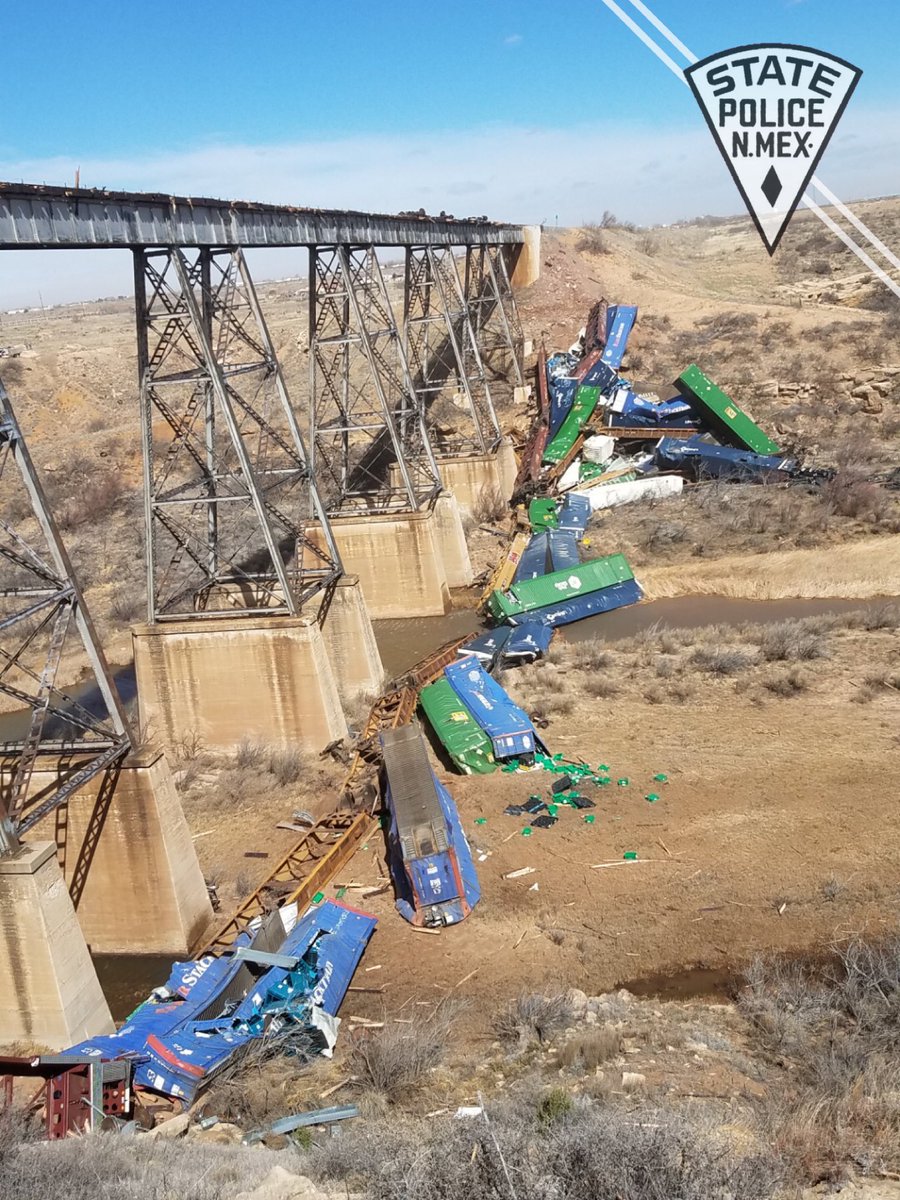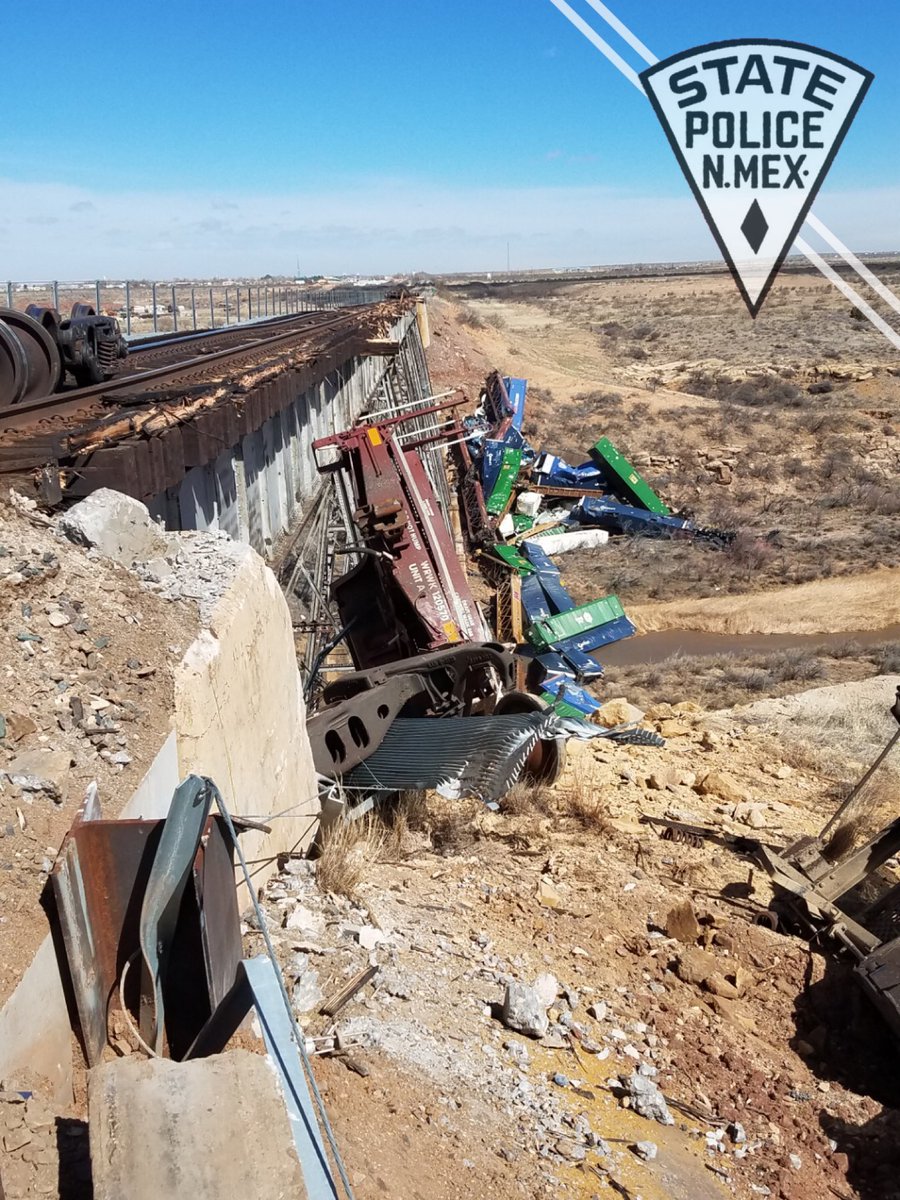Twenty six cars of a Union Pacific freight train derailed on the bridge over the Canadian River near Logan, N.M., Wednesday afternoon. The New Mexico State Police reported that there were no injuries. Wind gusts of up to 64 mph were reported in the area at the time and were believed to be a factor in the derailment. Union Pacific spokeswoman Raquel Espinoza says the derailed cars were the tail end of a mixed-freight train consisting of two locomotives and 73 railcars.
This track is part of the UP Tucumcari Subdivision and is 196 miles long, extending from Vaughn, N.M., to Dalhart, Texas. It is single-tracked main line and hosts 10 to 20 trains per day.
















Coming home from the TRAINS 75th anniversary dinner I was on the Empire Builder and we were held up at the Two Medicine River Bridge near East Glacier due to high winds.
W Cook, I understand what your saying now. I seem to have WALLS on my mind for some reason.
John Rice, I agree with Charles, not a bad idea!
John Rice, that seems like an excellent idea. I wonder if that has ever been considered by any railroad.
Sheldon, I did not suggest a Wall! But it might be possible. I suggest a chain link fence to cut the power of the wind, They would do testing to see how much of a barrier to wind that the bridge can handle. That is not hard engineering and there is no guarantee there would not be a tornado like what happened to the Kinzu viaduct.
Putting 15ft walls on bridges to cut wind, would turn the whole structure into a giant sail and take the whole bridge down!
I would just place a solar powered wind gauge at the bridge that triggers a signal about a mile before the bridge at either end to warn of high winds. This gives the dispatcher and the engineer plenty of time to make a movement decision.
Since they they have PTC now, I would just put micro weather stations at the PTC signal boxes along the ROW and piggyback the telemetry to the dispatcher so they can follow wind events (or other weather impacts) in real time.
Having the Weather Channel up on a big screen in the operations center is a nice to have but doesn’t report data localized enough for a wind event.
They are definitely well cars. Containers cannot be stacked on spine cars as spine cars do not provide enough vertical clearance.
Upcoming scratch and dent sale on some flat screen TV’s perhaps?
A similar derailment occurred with a double-stacked container train on the Huey P Long Bridge during a night storm outside New Orleans about five years ago. It was caught on video from a dash camera in a parked automobile. The same bridge is used by The Sunset Limited.
Part of my apprehension with Superliners is that their high profile would be a disadvantage with strong winds on high bridges. A similar affect could happen to them with the narrower centre of gravity as the double-stacked container trains.
Gerald those are well cars.
Time to build some 15 foot high chain link fences along the side of these high bridges to cut the power of the wind, and have them help wind break to protect the trains.
Penelope Vinson,
Your apprehension about Superliners on a high bridge with high winds is a lot less warranted than with double stack intermodal containers in non-well cars. The Superliners actually have a lot lower center of gravity than compared to an intermodal car with double stacks, they’re also not as tall as a double stack which can reach 20’2″(for double stacked high cube containers) above the rails vs 16′ 2″ for Superliners, that’s an additional 4 ft difference in height that would affect the center of gravity. Also, those do not look like well cars at all, just spine cars, which means that the containers themselves provide some of the stability.
NS learned from PRR and PC to park a loaded coal train on Rockville Bridge in times of heavy windstorms.
The BNSF had a standing train blown off the tracks about 100 miles south of Logan a little over 3 years ago. The train stopped for high winds, but even standing still the winds were too much for the double stacks.
It could have been far worse. Through out much of New Mexico on the 13th, winds were crazy everywhere. Here in Dona Ana County winds were clocked at about 104 mph on San Augustin Pass. (YIPE.)
If memory serves right (and I’m sure someone will probably mention it), there was a derailment similar to this further south on the line, somewhere, that was blown over by high winds.